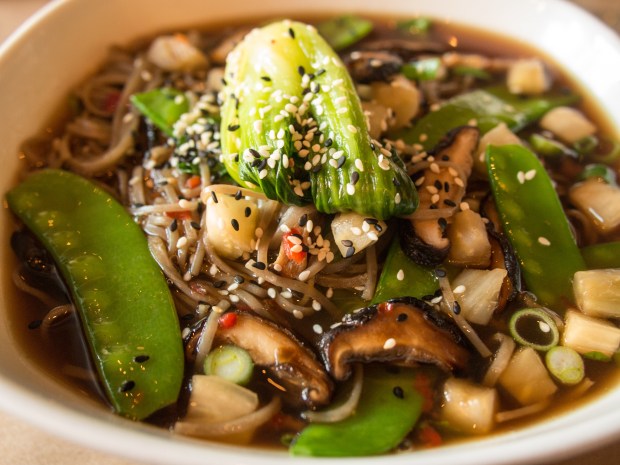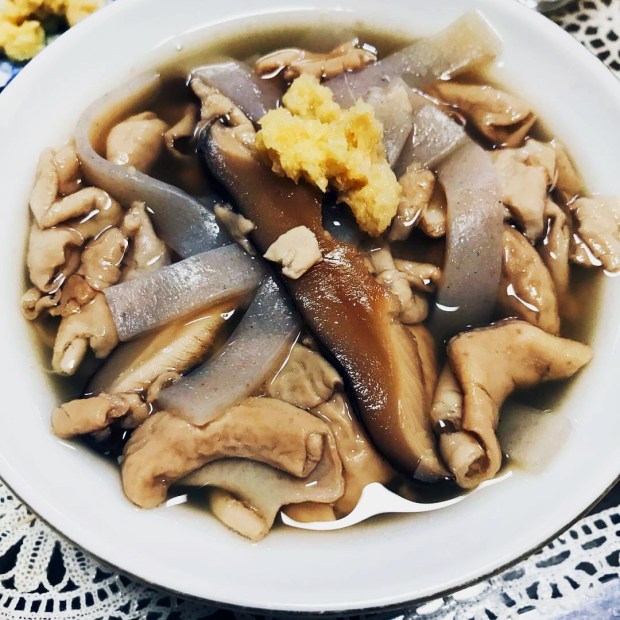Japan’s southernmost prefecture is closer to Taiwan, mainland China, and Korea than it is to Tokyo. This distance from the mainland has shaped Okinawa’s politics, culture, and gastronomy from the time it was a Chinese-affiliated kingdom called Ryukyu through Japanese annexation, World War II, and the postwar reconstruction
In the 14th century Okinawa’s three kingdoms—Hozukan, Nanzan, and Chūzan—emerged as the heart of the Ryukyu kingdom under the dominion of China’s Ming dynasty. Many Chinese served in Ryukyu, which became a trading center; food products and techniques from Southeast Asia, China, and other places that traded with China influenced the culture of the Ryukyu Islands.
The Ryukyu court used long grain Thai rice and distillation techniques from Thailand to make one of Japan’s greatest beverages, awamori, which is only now generating interest in Tokyo and abroad. Once considered a lesser shochu, awamori’s unique flavor is gaining respect by true spirit aficionados. From the Ryukyu kingdom comes court cuisine, which includes Okinawan classics like rafutei, tōfuyō, mimigā, and nakami-jiru, highlighting Aguu pork, the top brand in Japan and the name of the Okinawan pig breed that dates back to the Ryukyu kingdom.
From 1372 until 1590, the Ryukyu traded throughout Southeast Asia. During this period, Okinawa and the other islands of the kingdom absorbed products and recipes from abroad that shaped the island’s cuisine into something unlike any other prefecture in Japan. One of these products was a locally raised breed of pig.
Okinawans, like Oaxacans in Mexico, are Okinawans first, then Japanese.
Like many Okinawan foods, Aguu pork is lean, low in cholesterol, and easily consumed from head to tail. There is Okinawan expression about pork: Everything is eaten except the squeal.
By 1609 the shogunate had invaded Ryukyu. Okinawans then found themselves paying tribute to both the shogunate and the Qing dynasty, a relationship endorsed by Japan to avoid a costly war. By 1879 Okinawa had been formally incorporated into Japan as the Okinawan prefecture, but it remained distinctly Okinawan, with its own language and its own outlying food culture. Okinawans, like Oaxacans in Mexico, are Okinawans first, then Japanese.
From Southeast Asia came fruits, vegetables, herbs, and spices such as turmeric. Okinawans use mushrooms less than Japanese do, and theirs is a more meatcentric diet. Ingredients like the purple sweet potato and Spam arrived from North America. They also developed a taste for Mexican-American flavors, giving rise to the beloved taco rice, invented to appeal to the U.S. military forces that have remained on the island since the Battle of Okinawa in 1945.
Since the days of the Ryukyu kingdom gōyā, kombu, shīkwāsā (Okinawan lime, squeezed over practically everything), pork, goat, taro root, and umi budō are some of the foundational ingredients of Okinawan flavors. Orion beer, awamori, and very un-sobalike soba are a rebel blast of Okinawan culture across the bow of mainland Japan’s austere traditions and precise styles. More simply put, Okinawan cuisine is Japan’s soul food, hailing from one of its most fascinating regions, lesser known by foreigners and even most Japanese.

Gōyā chanpurū (Bitter gourd stir-fry with Spam)
Chanpurūs are Okinawan stir-fry dishes cooked with a base of tofu. You can check off a few local ingredients in an island saute of goya (bitter melon), Spam, egg, and whatever else you desire. The key element here is lots of bitter melon, one of the healthy foods in the Okinawan diet, eaten with salty, savory Spam or pork to counter the brackishness of Okinawa’s bumpy gourd, originally brought to the island by the Chinese.
Beni-imo chippusu (Purple sweet potato chips)
There are a variety of ways to have purple sweet potatoes, a defining component of the Okinawan table, but start by grabbing a bag of chips at the store or order them at a bar to snack on with your Orion, Okinawa’s local brew, or a shot of awamori.
Erabujiru (Sea snake soup)
Around the islands of Kudaka, Ishigaki, and Miyako, the venomous black-banded sea krait, or erabu, has been captured since the epoch of the Ryukyu kingdom as a court-cuisine delicacy. Before it is smoked, the black and silver stripes of the erabu appear as an undulating necklace worthy of a pharaoh’s tomb. Once smoked, the snake is rehydrated and cooked in a dashi broth with kombu and pig trotters, its soft, gelatinous skin matched by the tenderness of the trotters for a truly aristocratic pleasure.

Hiijā sashimi (raw goat)
In order to dampen the strong bouquet and powerful taste of raw goat, the meat is nearly frozen, then sliced razor thin with lots of grated ginger. This is an unusual dish even to mainland Japanese. Just add lots of awamori and there’s nothing more conventional in Ryukyu.
Hira yāchii (Okinawa-style okonomiyaki, a savory pancake)
The Okinawan version of Japan’s fashionable savory pancake is thinner than the renditions offered in other prefectures, especially in Kansai and Hiroshima, where okonomiyaki is more prominent. It is a flat fry of flour, egg, water, seasoning, and green onion, mixed together, fried in oil, and topped with bonito shavings and Worcestershire sauce. Okinawa’s interpretation is more like Korean chijimi than mainland okonomiyaki. Traditional add-ons of goya, mozuku, or corned beef vary by region; leeks are also legit. Few restaurants offer this party favor—it’s more of a dish to cook at home with friends and loved ones.

Jiimāmii dōfu (Peanut tofu)
This dessert like potato-starch and peanut-extract tofu makes for a delightful after-dinner course with a little grated ginger, wasabi, or soy sauce sweetened with Okinawan brown sugar. It’s commercially available in grocery stores, sold from packages that include a sweet peanut sauce or other syrupy dressings.
Jūshii (Rice porridge)
The luckiest of you will be invited into an Okinawan grandmother’s home for a bowl of jūshii, an island comfort of flavored rice porridge seasoned with pork broth and lard. The customized additions of local vegetables, pork cuts, and oceanic treasures vary from family to family. You can find this dish in restaurants, but it really lives in Okinawan homes.
Kokutou (Brown sugar)
Leave it to Okinawans to have healthy sugar. The island’s brown sugar is made by boiling unrefined sugar in a process that leaves it rich in minerals and with a more natural flavor. It’s an essential ingredient in Okinawan foods, in drinks like coffee and tea, and in various candies.

Mimigā (Pig ear in vinegar)
This pickled salad of pig ear strips with sliced cucumber is required bar food when drinking awamori or Orion beer at an Okinawan izakaya. Pickled pig ears are part of the island’s chinmi, the strange foods engineered for snacking at the bar. It is a quintessentially Okinawan experience to nosh on bold, daring bar bites while sipping the local elixirs and toasting your friends.
Tako raisu (Taco rice)
Take the ingredients of a Mexican-American crunchy taco—ground meat, shredded yellow cheese, tomatoes, bottled salsa—and spoon them over steamed white rice and you have tako raisu. Americanized tacos were introduced to Okinawa by the U.S. military, but Okinawans thought that tacos were not substantial enough for a meal if you were hungry. So, just like Mexican-Americans in the U.S., Okinawans rounded out the meal with rice (while skipping the beans) for a plate beloved by locals and foreigners alike.

Okinawa soba (Soba noodles with vegetables)
The thick wheat noodles in Okinawan soba have nothing to do with the regional Japanese styles of thin soba noodle made from buckwheat, nor with Nagano-style soba noodles, which are a combination of wheat and buckwheat. Let purists be damned, though. Okinawan soba, which more closely resembles udon, adds a taste of China care of pork cuts such as sōki soba (see below) and tebichi soba (see below), as well as chile flakes brought from China via the Columbian Exchange. The broth is made from any combination of pork leg bones, bonito flakes and kombu, or purely pork leg bone on bonito flake for a clear, flavorful base. The finishing touches are diced scallions and a pinch of Day-Glo red pickled ginger.
Sōki (Pork spare ribs stewed with bone)
Another coveted pork cut, spare ribs, are stewed with their bones and cartilage attached, then used in sōki soba and sōki jiro, a soup served with the ribs, kombu (brown seaweed), and daikon.
Nakami-jiru (Pork-tripe soup)
For the best flavor and texture Okinawans take their chitterlings and soak them in milk after a good cleaning to remove any foul odors, then cook them slowly in a clear fish or pork stock with dried shiitake mushrooms, bean curd leavings, and sometimes stomach. This is a celebratory dish served on Saturdays, during Obon or on New Year’s Day. It’s also a perfect hangover cure, in case you drink too much of an inferior awamori.

Rafutei (Simmered pork belly)
This plate of thick-cut pork belly glazed with soy sauce, awamori, katsuo dashi, and Okinawan brown sugar stands out among the global trend of pork-belly dishes. That’s thanks to the lean, rich taste of its Aguu pork, which is 100 percent Okinawan and the most respected brand of pork in Japan. From the courts of Ryukyu to modern-day restaurants and Okinawan homes, this dish is an indulgence of meltingly tender pork with a natural pork taste that’s out of this world.

Tōfuyō (Fermented tofu)
There is stinky tofu, Taiwan’s powerfully scented tofu fermented in an umami-packed brine, and then there’s tōfuyō, the regal variation of malodorous tofus, worthy of the finest multicourse menus enjoyed by the Ryukyu monarchs. “Island tofu,” a popular name for this dish, consists of a firm tofu that’s had the water squeezed out (much like mainland momen tofu), then is fermented in awamori and red koji. Okinawan households are as loyal to their favorite tōfuyō makers as Époisses natives are to Époisses de Bourgogne cheese. You can earn instant respect for appreciating this pungent, red velvet cake–colored dish, paired with a strong awamori.

Tebichi soba (Stewed pig’s foot with soba noodles)
Okinawa’s most popular noodle, soba, of course has a variety of pork toppings, making for a bowl of silky, smooth noodles in a clear pork-leg-bone or bonito broth. It’s perfect for a hot day on the island. Add pig’s feet, simmered until small pieces can be torn off with a light tug from chopsticks, for a unique island expression of Japanese noodles.
Umi budō (Sea grapes)
A staple of the Okinawan table, sea grapes offer a delicious squirt of briny liquid from a translucent green string-of-pearls configuration. You’ll find this local, healthy seaweed served as a side dish, as a topping on Okinawan soba, or as a garnish for sashimi, to be dipped in soy or vinegar. Sea grapes are high in minerals and low in calories. If you think Okinawans consider this elegant, tasty side dish a key to their longevity, you guessed right.
Sunui tempura (Pickled kombu tempura)
Regional tempura, a technique adopted from mainland Japan, incorporates Okinawa’s unique products, like purple sweet potatoes, goya, and kombu. The seaweed is pickled in vinegar and can be enjoyed in its slimy state, but the best way to eat kombu is in tempura batter. The salty, piquant flavors of pickled seaweed are balanced by the light, crisp batter.
Sātā andagii (Okinawan doughnuts)
Mix flour, eggs, milk, vanilla, sugar, baking powder, and salt and you have a doughnut. But in Okinawa it’s the kokutou, or Okinawan brown sugar, that gives these golf ball–size treats their provincial flair. You can find these doughnuts everywhere in Okinawa—as a street snack or a sweet finish to a meal on the island.
